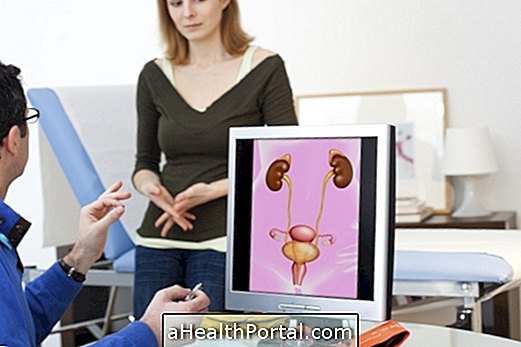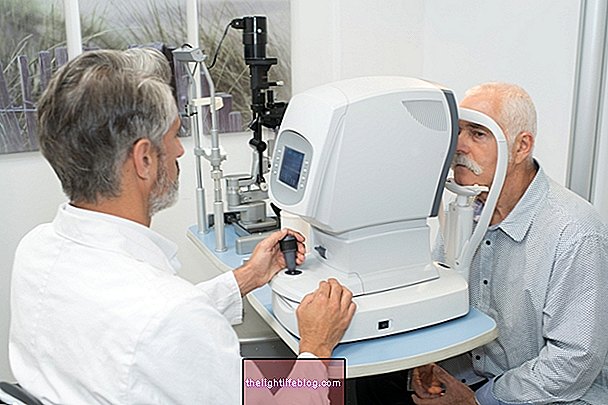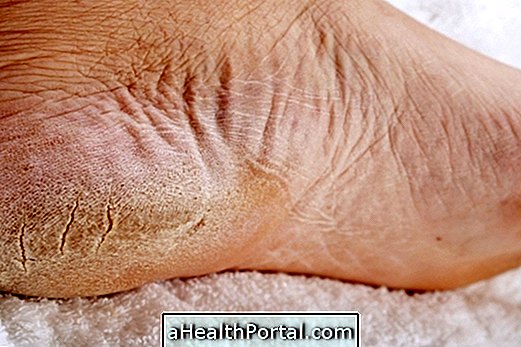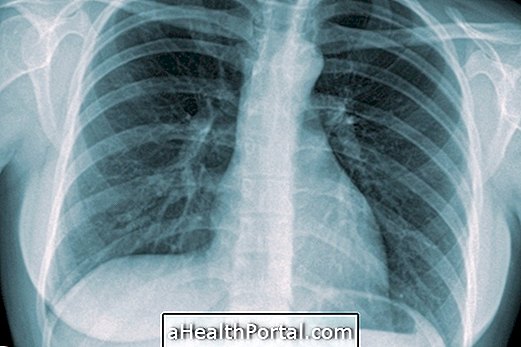The lower bladder occurs when the pelvic floor muscles and ligaments can not hold the bladder in place, so it 'slips' from its normal position and can be easily touched through the vagina.
This may be called cystocele, bladder prolapse, low bladder, or fallen bladder, and is more common in women over 40 years of age who have become pregnant. The woman may have only the sagging bladder, but the uterus, urethra, and rectum can also fall at the same time.
Treatment for low bladder can be done with changes in lifestyle, weight loss, smoking cessation, constipation, physical therapy, pelvic exercises, indicated by the physiotherapist, or through surgery in the most severe cases, when the bladder reaches the entrance of the vagina or through the vagina.

How to know if the bladder is low
Signs and symptoms that indicate that the bladder is fallen include:
- Lump in the vagina, which can be seen with the naked eye or felt with the fingers during the vaginal touch;
- Feeling of weight in the bladder;
- Pain or discomfort in the pelvic region;
- Weakness or flaccidness of the perineum muscles and ligaments;
- Unintended loss of urine may occur;
- Difficulty in passing urine during the first few seconds of urination;
- Urgency and increase of urinary frequency;
- Pain and irritation in the vagina during sexual contact;
- In case of prolapse also of the rectum, there may be a formation of a 'pouch' near the anus causing pain, discomfort and difficulty to eliminate the stool.
The gynecologist is the most appropriate doctor to make the diagnosis and indicate the treatment for low bladder cases, but the treatment can also be directed by the physiotherapist.
Low bladder examination
The exams that may be requested by the gynecologist for evaluation of the fallen bladder are:
- Evaluation of pelvic muscle strength;
- Transvaginal ultrasound: to evaluate the muscles of the peri-anal region and evaluate if there is any change in the uterus, emptying of the bladder or urethra;
- Urodynamic studies: to assess the ability of the bladder to retain and eliminate urine;
- Magnetic resonance: to have a better visualization of all the structures of the pelvic region.
- Cystourethroscopy: to see the urethra and bladder, in women who present with urgency, urinary frequency, bladder pain or blood in the urine.
Bladder drop is most common during or after menopause, after pregnancy, in cases of constipation, after surgery to withdraw from the uterus, in case of overweight or obesity, after the age of 50, and in women who smoke.
Another situation that favors bladder sag is jobs that require physical exertion, such as housework or where it is necessary to hold or carry heavy objects. So, to prevent the bladder from falling again, all these factors must be avoided.
Treatments for low bladder
The treatment varies according to the degree of cystocele that the woman has:
| Type | Feature | Treatment |
| Grade 1 light | Small bladder drop in the vagina, no symptoms | Pelvic Exercises + Life Changes |
| Grade 2 - moderate | When the bladder reaches the opening of the vagina | Physiotherapy + Pelvic Exercises + Surgery |
| Grade 3 - serious | When the bladder exits through the vagina | Surgery + Physiotherapy + Pelvic Exercises |
| Grade 4 - very serious | Complete bladder outlet through the vagina | Immediate Surgery |
1. Exercises for low bladder
Kegel exercises are indicated for less severe cases, where the woman has a weak bladder or pelvic muscles, with few symptoms, and therefore surgery is not indicated. These exercises should be performed daily to have the expected effect and are very effective when performed correctly.
How to do kegel exercises:
- Empty the bladder;
- Identify the pubococcygeus muscle: for this, try to stop the jet of urine while urinating;
- Re-contract the pubococcygeus muscle after urinating to make sure you know how to contract the muscle properly;
- Perform 10 consecutive muscle contractions;
- Relax for a few moments;
- Resume exercise by doing at least 10 sets of 10 contractions every day.
Kegel exercises can be performed in any position, whether sitting, lying or standing, and can even be performed with the aid of fitness balls. However, it is easier to start lying down with your legs bent. Watch more details on this video:

How to do hipopressive gymnastics:
Hipopressive gymnastics is also indicated to combat the bladder because it also helps strengthen the pelvic floor muscles. To do:
- Breathe in normally and let the air out completely until the abdomen begins to contract on its own and then 'shrinks', sucking the abdominal muscles inwardly, as if it were to touch the navel in the back.
- This contraction should be maintained for 10 to 20 seconds initially and over time, increasing the time gradually, remaining as long as possible without breathing.
- After the pause, fill your lungs with air and relax completely, returning to normal breathing.
See the step-by-step of hipopressive exercises in this video:

2. Physiotherapy for low bladder
In physical therapy, in addition to the exercises indicated above, there are still other possibilities, such as the use of a small device that is used to place inside the vagina to help hold the bladder, pesinhas that are small lead balls of varying weights that can be inserted into the vagina during exercise.
Other features that can also be used are intravaginal electric stimulation or biofeedback which are devices that help the woman to become more aware of her pelvic muscles in order to facilitate the performance of the exercises correctly.
Physiotherapy in women's health consists of individual sessions, lasting from about 30 minutes to 1 hour, which must be performed at least once a week, although exercises should be performed at home every day. Learn more details of physical therapy for urinary incontinence.
3. Remedies for low bladder
Some estrogen-based remedies may be used during menopause to help control the symptoms of cystocele, so hormone replacement during menopause is also indicated to complement treatment in some women. Learn more about hormone replacement.
4. Low bladder surgery
The surgery for cystocele consists of strengthening the structures of the pelvic region to restore the correct position of the bladder, uterus and all structures that are 'dropped'. Usually the doctor puts a 'net' to serve as support for the pelvic organs which is quite effective, being especially indicated for the most serious cases.
This type of surgery can be done through laparotomy or abdominal cutting, with regional or general anesthesia, but like all others it has its risks, such as perforation of organs, bleeding, infection, pain during sexual contact and return of urinary incontinence, in some cases.
The surgery is quick and the woman is hospitalized for only 2 or 3 days, but it is necessary to stay at home and avoid efforts in the first week after surgery. Learn more about recovery from this type of surgery in: Surgery for urinary incontinence.

























